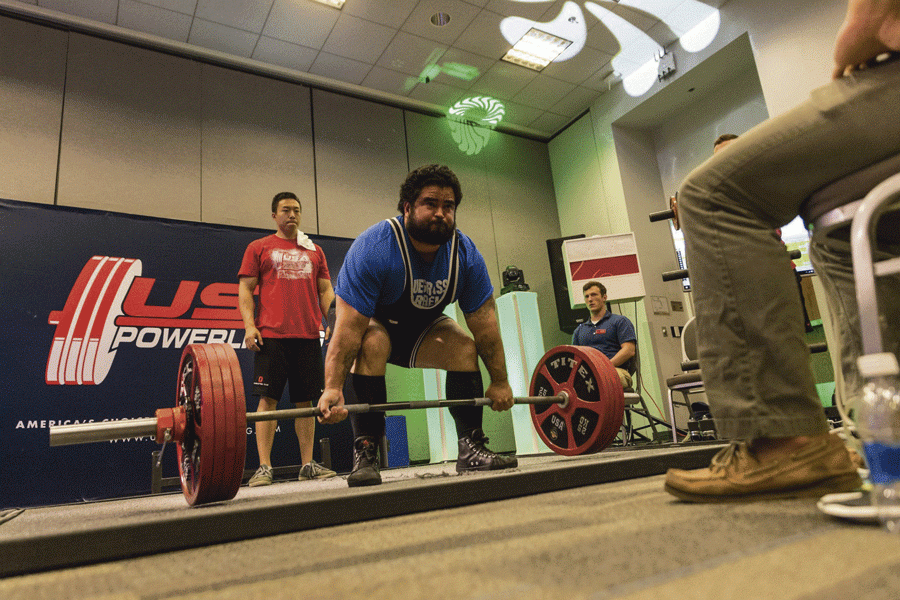Getting Smarter, Not Weaker
Tony Pacheco attempting a 227.5 kg deadlift (501 lbs.).
August 25, 2016
Finding the things you’re good at can be a difficult task. Some people find it earlier in life, others find it later.
For me, it was much later.
On Sunday July 31, I competed in my 8th powerlifting competition – the USA Powerlifting Ohio State Championships in Columbus, Ohio.
Powerlifting is a rather straightforward sport. An athlete has to lift the most weight they can in three different events, the squat, bench press and deadlift, getting three attempts in each. Three judges judge the lift by giving the lifter either a white or red light. A miss can occur if the athlete gets two red lights from the judges for either not being able to lift the weight or lifting the weight improperly. The athlete’s score is based on the total weight lifted in each event.
Like any other sport, powerlifting requires dedication and hard work. Only serious athletes will truly succeed.
Although powerlifting is a competitive sport, the biggest opponent a powerlifter will face is themselves.
I have competed in local, state, regional and national competitions, but things did not go as planned in Columbus.
Over the summer I spent almost a month overseas and away from the gym. Having only 5 weeks to prepare when I returned, my performance suffered greatly.
I missed my second and third attempt in the bench press, and my third attempt in the deadlift.
It was not the performance I was hoping for. But what keeps me coming back time and again is the camaraderie and atmosphere of the powerlifting community.
I have been lifting weights in some form since high school, whether it was powerlifting, bodybuilding or strongman.
However, it was not until 2007, when I moved to Louisville, that I decided to take weight training seriously. Even then, it took me several more years before I decided to compete.
I had just turned 29 and I was at a crossroads in my lifting career. I had made significant gains throughout my 20s, increasing my muscle mass and total numbers. However, I was not where I wanted to be.
In 2012 I enrolled at IU Southeast, but I was still not completely satisfied with where I was physically. Going back to school had drastically decreased my physical activity.
Additionally, my recovery time is no longer where it used to be. I can no longer pair training for hours with long nights of studying and still see any kind of significant gains. I have to be more cognizant of my limits.
After going nowhere in my training, I decided to look for a gym and a coach that could guide me to where I wanted to be. That is when I found Bluegrass Barbell in 2014.
Bluegrass Barbell and CrossFit Louisville is a CrossFit and Olympic weightlifting gym in Louisville. Through the owner and head coach, Ben Carter, I found a place that would take me to where I wanted to be.
Yet even in the few short years I have competed, I have found that strength is harder to maintain. As I have become more and more immersed in the world of athletic performance I have found that it is a common trait among even the most athletic individuals.
Susan Kwasny, a sports administration major from the University of Louisville, fitness instructor and a powerlifting teammate at Bluegrass Barbell, knows firsthand the difficulty in maintaining and building strength and athletic performance as you age.
The 39-year-old Kwasny said she played some sports in high school but it wasn’t until her early 30s, after discovering CrossFit, she found powerlifting.
“I did CrossFit for about a year but I wasn’t really getting anywhere,” Kwasny said. “My athletic ability wasn’t quite right for the sport of CrossFit.”
Kwasny would eventually move on to powerlifting through her coach and, by the age of 34, she was competing in powerlifting competitions.
Kwasny said as she has gotten older her lifts are no longer increasing as much as they were when she started in her early 30s, but it is the recovery time that she believes is the biggest disadvantage as you age.
“If I lift with someone who’s in their early 20s and we do the exact same workout their body tends to recover a lot quicker,” Kwasny said. “It may take my body two days to recover and their body less than a day to recover. And then also the injury rate is higher.”
Kwasny said she has learned a lot throughout her years of training and powerlifting when it comes to strength and athletic performance.
“What I learned through all of my training and schooling was that essentially we peak out in our 20s,” Kwasny said. “Form becomes so, so, so important, because injury rates really grow as they get older.”
O’Malley Dreisbach, owner of Dreisbach Wholesale Florists, is an Olympic weightlifter at Bluegrass Barbell where I train. At 47, he currently competes in the masters division of Olympic weightlifting.
Dreisbach said he has been competing in the masters division for three years. He started in CrossFit, like Kwansy, but eventually turned to Olympic weightlifting.
Dreisbach said his training has changed as he’s gotten older.
“I respect my body a lot more than I did when I was younger,” Dreisbach said. “I do a lot more stretching before and after workouts.”
Dreisbach said he now watches what he eats and tries to make sure he maintains his energy levels. He said he does not drink as much alcohol anymore and drinks a lot more water.
As for me, I will continue to work hard to achieve my goals. My goal now is to qualify for the Arnold in Columbus, Ohio.
Getting older doesn’t mean getting weaker. It just means you have to be smarter with your training.


